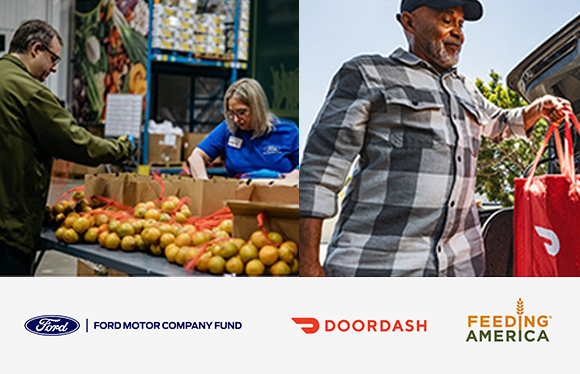
Ford Mobility Research in the Michigan Central Impact Area
Ford is conducting pilots and testing in and around the Michigan Central impact area to build mobility solutions for the future.
Over the last six months, Ford and its philanthropic arm, Ford Motor Company Fund, launched an autonomous fresh food delivery pilot, which brought fresh food to the doorsteps of senior citizens in Southwest Detroit. This service was integrated with the Ford Fund’s existing operations, FREC on the GO, which delivers healthy foods throughout the community. While this particular pilot has come to an end, if residents live within the program area and are interested in receiving a fresh food delivery in the future, please reach out to 313-806-0370.

If you are in the Michigan Central impact area, you might still see our shuttle driving around. While we aren’t making deliveries, we are continuing to build and research the autonomous technology and how we can use smart infrastructure nodes and teleoperations to communicate to our vehicles and provide an added layer of safety. Our vehicles will continue to have human safety operator behind the wheel.
FAQ
- Why is Ford concluding its pilot? Ford is testing and researching a variety of solutions in and around the Michigan Central impact area to help improve mobility and how people and goods move in the future. We believe there are a variety of autonomous form factors that could be used in the future to move people and goods, our autonomous delivery pilot was a part of that. We will continue to test the autonomous technology, and FREC on the Go will continue to delivery healthy foods via their driven program. We will also take the learnings from our pilot and apply it for the future.
- How can people sign up for FREC on the Go? If residents live within the program area and are interested in receiving a fresh food delivery in the future, please reach out to 313-806-0370.
- Why is your shuttle still driving around the Michigan Central impact area if your pilot has ended? While our delivery pilot with FREC on the Go has concluded, we are still operating our shuttle to build and research the autonomous technology and how we can use smart infrastructure nodes and teleoperations to communicate to our vehicles and provide an added layer of safety. Our vehicles will continue to have human safety operator behind the wheel.
- What kind of technology is on the Ford infrastructure smart node? The Ford-designed infrastructure nodes are designed to serve only to help an autonomous vehicle navigate complex and crowded intersections. The nodes are equipped with lidar, radar, cameras and sensors – which is the same technology on an autonomous vehicle which allows it to see and navigate without a human driver. This combination of sensor technology – lidar, radar, and cameras – enables Ford’s nodes to communicate with its autonomous shuttle to help provide it with as much information as possible. As a result, this provides an added layer of safety.
- How does the infrastructure node work? Situated above an intersection, Ford’s infrastructure node can get a comprehensive view of what’s happening in all directions and offer a “bird’s eye view” of knowledge to support an autonomous vehicle, which is also analyzing its immediate surroundings at the street-level at the same time. Equipped lidar, radar, cameras and sensors, the Ford infrastructure node quickly relays information to its autonomous vehicles to let them know what they are driving towards as they approach an area or situation.
- What types of data is being captured on the Ford infrastructure smart nodes? The Ford infrastructure node serves only one purpose – to help an autonomous vehicle navigate complex and crowded intersections. By design, the nodes are not capable of capturing personally identifiable information or license plate detection. The technology only detects silhouettes of objects such as a static sign, or a moving car or bicyclists, so the autonomous vehicle knows how to predict behavior and make smart decisions.
- Is this type of data shared with third parties? Data captured by the smart infrastructure node is not shared with any third-parties, law enforcement or government agencies. It is strictly used within Ford to help the autonomous vehicle communicate and for technology development purposes.
- Why do you need the infrastructure node? The Ford-designed infrastructure nodes provide an added layer of safety for autonomous vehicles to provide them with as much information as possible to help it navigate complex and crowded intersections. For example, if a bus or truck is blocking the autonomous vehicle sensors’ direct line of sight, the vehicle can know even quicker if another vehicle is approaching from around the corner at an unsafe speed.
- Will the Ford infrastructure smart node always be “on”? No. The Ford infrastructure smart node serves only one purpose – to help an autonomous vehicle navigate complex and crowded intersections. As a result, our nodes will only be utilized when our autonomous vehicle is operating.
- Is this the first time Ford has used its infrastructure node? No. Ford has already conducted research in Saline, Michigan and Miami, Florida.
- Will the infrastructure node be removed after the research has concluded? Yes. Ford is responsible for removing the technology at the conclusion of the research.
- Who designed the artwork on the shuttle? The Southwest Detroit community is represented through an inclusive piece of artwork designed by Detroit School of Arts student, Brooke Snow.


